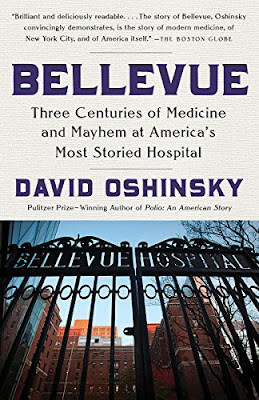 Here are a few excerpts from a book I recently read, "Bellevue: Three Centuries of Medicine and Mayhem at
America's Most Storied Hospital," by David Oshinsky.
Here are a few excerpts from a book I recently read, "Bellevue: Three Centuries of Medicine and Mayhem at
America's Most Storied Hospital," by David Oshinsky.
Some New Yorkers saw cholera as a blessing in disguise.
“Those sickened must be cured or die off,” wrote an unforgiving
official, “& being chiefly of the very scum of the city, the quicker
[their] dispatch the sooner the malady will cease.” For him and his
allies, the answer lay in restricting the flow of immigrants to America
and quarantining those who did reach its shores.
Others
disagreed. The Irish were here to stay, they thought, and not likely to
change on their own. Cursing their filth and intemperance, while a
natural response, did little to prevent epidemics that put the entire
city at risk. A more practical approach was to focus less on the moral
failings of these immigrants, which city officials couldn’t effectively
control, and more on the environmental causes of disease, which they
could. If foul vapors and general filth were the cause of cholera and
other epidemic diseases, then why not whitewash the tenements and close
down the stinking wells?
In
antebellum New York, much like today, wealth played a key role in one’s
health care. The rich paid handsomely for the privilege; the poor
relied on the charity of others. Yet what neither side fully grasped
were the slender distinctions that separated the “best” from the “worst”
medical treatment of this era—a time of painfully slow progress in the
field. Money may have provided the illusion of proper care, but it did
nothing to protect a child from diphtheria, a mother from puerperal
fever, or a father from tuberculosis. The medical profession simply
lacked the tools to be effective. As the physician-philosopher Lawrence
Henderson aptly put it, “a random patient, with a random disease,
consulting a doctor at random had no better than a fifty-fifty chance of
profiting from the encounter.”
The
same went for hospitals. Americans saw little need for them in the
early 1800s because what occurred there could be done more safely and
comfortably at home. Lacking anesthesia, antisepsis, and X-rays, among
other modern essentials, the hospital resembled a poorhouse with a
vaguely medical bent. No institutions except the military and the
penitentiary seemed as perilous to human health. Even in London, where
the tradition of hospital care was far stronger than in the United
States, “the probability of a sick man dying [in] one,” reported a
medical board in the mid-nineteenth century, was “many times greater
than had he stayed away.”
Physically,
Bellevue was a wreck—a crumbling former almshouse so overcrowded that
patients could be seen sleeping on the floor. And so underfunded that a
survey of the nation’s hospitals in 1883 found the “cost-per-patient-per
day” at Bellevue to be 49 cents—the lowest figure by far in New York
City and well behind other metropolitan hospitals like Boston City
($1.24) and Cook County ($1.01).
Worse,
the 49-cent figure included supplies routinely pilfered from Bellevue,
where staff thievery was a way of life. Like many hospitals of this era,
patient recovery depended on generous alcohol use. “Spirits” at
Bellevue accounted for about 20 percent of its annual budget, twice the
figure for “medicines.” By one estimate, however, barely 5 percent of
the beer, brandy, whiskey, and wine actually reached the mouths of the
intended. “It is a mighty dry place,” wrote the rarely sarcastic New
York Times, noting “the wonderful evaporating power of the atmosphere
around Bellevue Hospital.”
One
thing was certain: the AIDS Unit wasn’t about saving lives. Five years
into the epidemic, there was no cure in sight. And that put a premium on
greater patient comfort and care. According to the nursing supervisor,
AIDS offered a prime example of what her profession did best. It was,
she said, “a nurse’s disease” rather than “a doctor’s disease”—not just
because nurses spent more time with patients, but because their skills
were better than anything “a doctor can prescribe.” The evidence ranged
from a device the nurses designed that allowed those with painful mouth
sores to chew their food more comfortably to the simple kindness of
allowing the patient’s partner to stay beyond visiting hours. “It may
sound corny,” an AIDS nurse added. “But when you’re caring for someone
who knows he’s going to die, you know he needs you….All that’s left are
two human beings.”


No comments:
Post a Comment